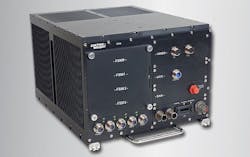Rugged data storage for aircraft UAVs, and mobile radar introduced by Curtiss-Wright
ASHBURN, Va., 6 June 2014. The Curtiss-Wright Corp. Defense Solutions division in Ashburn, Va., is introducing the rugged CNS4 compact network data storage subsystem for demanding military applications like transport aircraft, helicopters, unmanned aerial vehicles (UAVs) and mobile radar systems.
The CNS4 is a conduction-cooled, high-performance network file server (NFS) with scalable storage, flexible I/O, and encryption options. This rugged, high-capacity storage solution is for size-, weight-, and power (SWaP)-constrained military applications that require cryptography to ensure the integrity of critical "data-at-rest."
The CNS4 high-density storage capacity, support for several network protocols and expansion, and flexible encryption capabilities enable system designers to address data, audio, and video storage requirements with one solution, eliminating the need for several dedicated data recorders, company officials say.
Able to support as much as eight terabytes of Type 1 encrypted storage, CNS4 provides Ethernet connectivity for network-agility. It also supports industry standard protocols such as CIFS, NFS, HTTP, FTP, and PXE.
The modular CNS4 supports a variety of encryption levels and can be configured with as many as four Curtiss-Wright Flash Storage Modules (FSM-C) in a rugged, conduction-cooled ATR chassis, doubling the storage capacity available with the original CNS.
The CNS4 has 100,000 insertion cycle connectors for mobile applications such as mission recorders, unmanned vehicle data loader, mobile ISR systems and ground vehicles.
For more information contact Curtiss-Wright Defense Solutions online at www.cwcdefense.com.

